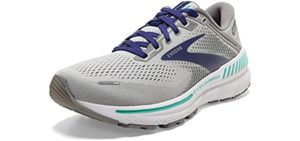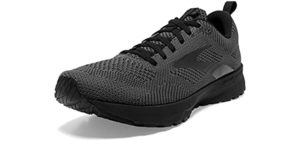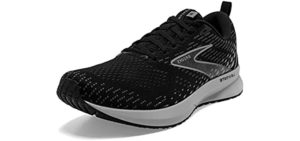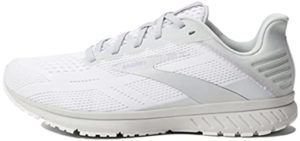Many athletes and runners are familiar with the term Peroneal Tendinitis, which is inflammation in your Peroneal Tendons that cause pain and stiffness.
Wearing proper footwear, such as Brooks shoes for Peroneal Tendinitis, may greatly increase your chances of healing and preventing the condition.
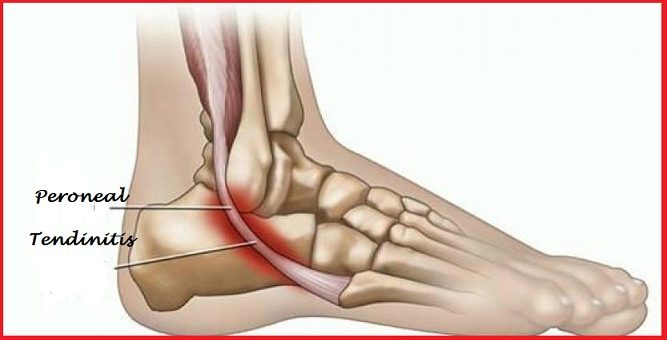
Table of Contents
- Peroneal Tendinitis Symptoms and Causes
- Shoes for Peroneal Tendinitis
- Features of a Good Brooks Shoe for Peroneal Tendinitis
- Reviews: The Best Brooks Shoes for Peroneal Tendinitis
- Index Table: Top Rated Brooks Shoes for Peroneal Tendinitis
Peroneal Tendinitis Symptoms and Causes
When damage or inflammation to the Peroneal tendon in your leg, you may have Peroneal Tendinitis. An increased load or overuse of these tendons leads them to rub against the bone, which over time may cause the tendons to thicken and become inflamed,
Peroneal Tendinitis is very popular in athletes and runners, especially when they have increased the times or intensities of their training, causing more use of the Peroneal tendon.
Especially sports such as running, where your feet roll outward, can cause Peroneal Tendinitis as there is much friction between the Peroneal tendon and the bone.
- Causes – Some of the more unlikely causes for Peroneal Tendinitis include having higher arched feet when you have an imbalance in your lower limbs or your lower limbs not working together properly. Other than that, Peroneal Tendinitis is mainly an overuse injury that is often caused by improper training techniques or suddenly increasing the speed, time, or intensity of your training. Wearing unsupportive footwear likewise places you at risk of suffering from Peroneal Tendinitis.
- Symptoms – You may have Acute, sudden, or gradual pain from Peroneal Tendinitis that worsens with time. The pain will be felt at the back of your ankle and may be worse with activity or when you turn your foot in and out. You may notice some swelling at the back of the ankle, and there may be instability in the ankle when you walk or bear weight. You may also feel the heat in the ankle area.
- Treatment – In the worst-case scenario, surgery may rarely be needed for Peroneal Tendinitis. However, it is good to reduce physical activity using rest, ice, or heat for pain and swelling in moderate conditions. You can use Physical therapy, prescribed medication, or cortisone injections for the pain.
- Prevention – Try to maintain a lower level of activity during the recovery period of Peroneal Tendinitis. When increasing your workload, gradually and always stretch before starting a routine. Supportive and well-cushioned footwear that supports your ankles will make a huge difference.
Shoes for Peroneal Tendinitis
Heel striking is much better than forefoot or midfoot striking when you have Peroneal Tendinitis. Therefore, shoes with a higher heel-to-toe drop are ideal, or with a Rocker style sole.
You will need ample cushioning, especially forefoot cushioning, and arch support specific for your arch type; as you will see, Brooks offers both Stability and Neutral support shoes.
Good ankle support is vital, and a more flexible sole for more natural movement will likewise be more comfortable.
Features of a Good Brooks Shoe for Peroneal Tendinitis

- Uppers – Brooks shoes come in a few options for uppers, they may have engineered mesh uppers, full grain leather uppers, Re-Engineered Creel warp mesh uppers, or Knit Uppers, depending on the shoe model. There may be 3D printed overlays for a more secure and structural fit and a comfortable liner, s well as a Gore-Tex membrane in the outdoor waterproof models. Most Brooks shoes have a padded collar and secure heel fit.
- Cushioning – Brooks uses a variety of cushioning systems such as their DNA Loft cushioning that is soft and responsive, the Bio Mo Go DNA cushioning that is more adaptive to your weight and speed, or the DNA AMP cushioning that has a higher energy return. You also get the DNA Flash cushioning, which is more stable and firmer, infused with nitrogen. Some shoe models have Segmented Crash Pads to provide more cushioning in the landing process from heel to toe.
- Support – For support, the stability shoe models from Brooks feature Guiderails that support and keep your feet in place to prevent excessive motion. Some models have an Extended Progressive Diagonal Rollbar (PDRB) that allows a more natural motion path.
- Outsole – Brooks shoes have a regular rubber outsole or their SATRA TM144:2011 approved slip-resistant rubber outsole. The Trail models have a Trail Track sticky rubber outsole with a Ballistic rock shield for underfoot protection.
- Options – Brooks shoes, as you will see, come in these width options; 2A, B, D, 2E, and 4E, which are wide and extra wide widths. They are also available in half and full sizes and many more colors.
- Types – Brooks shoes are available in Stability and neutral models. You will see that the stability shoes are GTS models that have a Guiderail system, which is a support technology that prevents excessive pronation and keeps your motion more natural.
Reviews: The Best Brooks Shoes for Peroneal Tendinitis
In our list, we have some of the top favorite Brooks shoe models that are all ideal for Peroneal Tendinitis;
1
Stability Running Shoe for Peroneal Tendinitis
- The Brooks Adrenaline is a supportive running shoe for Peroneal Tendinitis with a secure heel fit.
- The shoe has DNA Loft cushioning that is soft and comfortable.
- There are Guiderails for Stability and support.
- The shoe is available in wider widths and more colors.
2
Neutral Shoe for Peroneal Tendinitis
- The Brooks Launch is more of a Neutral running shoe for Peroneal Tendinitis.
- The shoe features a modern look, a secure lace-up system, and a heel fit.
- It has BioMoGo DNA cushioning that is balanced and adapts to your stride.
- The uppers are breathable, and the outsole is a flexible rubber design.
3
Shoe for Peroneal Tendinitis
- The Brooks is a neutral running shoe with a flexible outsole and traction features.
- It offers a secure heel fit and has engineered mesh uppers with 3D print overlays.
- There is a comfortable BioMoGO DNA foam midsole for support and cushioning.
- The inside is lined, and the collar is padded.
4
Stability Shoes for Peroneal Tendinitis
- The Launch GTS is their stability model from this range, with a Guiderail support system for light Stability in the midfoot area to prevent overpronation.
- It is suitable for neutral and lower arch types.
- The shoe has lightweight BioMoGo DNA cushioning and a 2mm thicker midsole for impact absorption.
- The uppers are a Creel wrap mesh that is lightweight and breathable.
5
Shoe
- The Levitate is a neutral running shoe ideal for Peroneal Tendinitis and has a more flexible sole.
- It features Energizing cushioning DNA AMP in the midsole and a more sock-like secure fit.
- The shoe is very lightweight and secure in the heel.
- It is available in many more color options.
6
Running Shoe for Peroneal Tendinitis
- The Brooks Anthem is a quality casual sneaker ideal for Peroneal Tendinitis.
- The shoe has engineered air mesh uppers that allow for better ventilation.
- It features segmented crash pads for optimal shock absorbency and a more flexible sole.
- The heel offers a secure fit to protect your ankles.
- There is a BioMoGO DNA cushioned midsole.
Index Table: Top Rated Brooks Shoes for Peroneal Tendinitis
| No. | Shoe | Men ♂ | Women ♀ | Features | Brand | Score |
|---|---|---|---|---|---|---|
| 1 | Brooks® - Stability Running Shoe for Peroneal Tendinitis | Adrenaline GTS 22 | Adrenaline GTS 22 |
| Brooks | 98.2 |
| 2 | Brooks® - Neutral Shoe for Peroneal Tendinitis | Launch 9 | Launch 9 |
| Brooks | 98 |
| 3 | Brooks® - Shoe for Peroneal Tendinitis | Revel 5 | Revel 5 |
| Brooks | 97 |
| 4 | Brooks® - Stability Shoes for Peroneal Tendinitis | Launch 9 GTS | Launch 9 GTS |
| Brooks | 97 |
| 5 | Brooks® - Shoe | Levitate 5 | Levitate 5 |
| Brooks | 97.5 |
| 6 | Brooks® - Running Shoe for Peroneal Tendinitis | Anthem 5 | Anthem 5 |
| Brooks | 96.9 |

